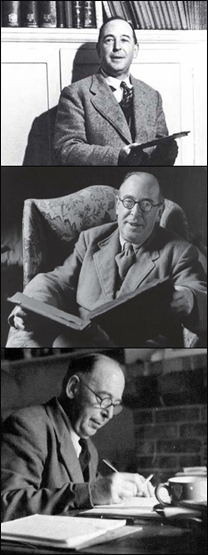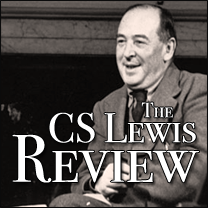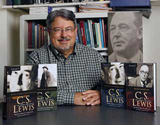
It’s Not a Tame Wardrobe: 2 Views & They’re Both Mine
December 8th, 2005 | Skip to comments
View One:
This is a Fantastic Film
I write first on behalf of the general viewer. Let’s say I read Lion as a child and have since read it to my kids, too–in the “original” order, by just dumb luck. I’m no scholar. I don’t know anything about Lewis’s childhood or Mrs. Moore or Greek mythology or who heads Walden Media. I am in the theatre to enjoy, to be entertained, to be swept away into Narnia. My Narnia–the one I remember, the one I cherish. I wouldn’t know an allegory if it bit me. But this I know: it’s Christmas, and, despite the temptations of secularism, I want to keep whatever there is of him, Christ, in Christmas, even if I barely know what that means. That’s why I’m here, in this theatre, wishing away winter so it can be Christmas again. This is the movie for me. So, when I get through the wardrobe, what will I find?
Old friends. Lucy, dear Lucy, played with grace and poise by Georgie Henley. And, wow, James McAvoy’s Mr. Tumnus: total verisimiltude. If the movie stopped here I would be on cloud nine or ten. This Narnia is an astonishing rendering. An amazing proximity to perfection. So, ok, I admit I’m home. Adamson did what he said he would: make the movie his 9-year-old self would. And that means certain things get focus, get screen time, and others don’t. It’s what a 9-year-old remembers.
First moments: I am in tears from the opening sequence—the German bombers–the race into the bomb shelter, and this new emendation: Edmund clutching his RAF father’s photograph in the broken frame–powerful; then the heart-rending railroad departure scene, the farewell to mother. Why the tears? I can’t believe I’m here, and believing, this is so rich, it can’t get any better than this, yet it does, in its subtlety and quiet pacing–the build up of the first 60 minutes is brilliant; we get to explore the house before Lucy goes in, before Edmund follows. We need this time, we need this seemingly pregnant pause, because once inside Narnia, once out of Spare Oom, the action and the landscape is “bigger on the inside than it is on the outside. . .” Moving too fast would spoil everything. And I’m not ready, I want to savor this, but, suddenly, then I am ready, for Edmund, and the Witch, for the betrayal. For the flight.
So, thanks, Andrew, for that first hour, for the well-placed humor and the light touch, for thereafter everything speeds up, gets darker, morning yet on creation day, and one by one, they come, first the Beavers, then the wolves, and the Witch’s lair, The thaw, Father Christmas, and then, finally, Aslan. Aslan with Liam Neeson’s lilting Irish tenor. Aslan’s first joyous then haunted presence. And then Edmund’s rescue, and the lull, and the Witch’s boasts, then the sacrifice, and the lonely vigil, and then the climactic battle–more battle than the eye can take in with a phantasmagoric menagerie of bountiful creaturehood. A victory! Aslan breathing life into lifeless statues–Mr. Tumnus first! And a pleasing jolt after the credits have begun to roll. Narnia has indeed come, the wardrobe has kept its promise. The eye and the ear have their feast, the heart its reward. There is nothing to apologize for, and nothing to debate. When does Prince Caspian start filming?
And now, stay tuned for a second view, one that casts aside the raw innocence of that first, hungry viewing, and begins to allow oneself to put some distance between the sheer joy of the movie’s existing at all, then permits space for reflection on three scenes that exemplify for me: what is left out, what is an interesting mistake, and, what is a twist that need not have been so. No need to read this before you go. Save it for after, after that smashing, wondrous, rush of spiritual adrenalin when Aslan is on the move. No harm done. This is a fantastic experience.
View Two:
You can only see a movie for the first time once.
A first viewing of great films is momentous, precious, effortlessly luminous and numinous, gripping from the magical opening sequence. I want Narnia to take me to that level of exultation. Is that demanding too much? Am I trying too hard? That answer needs a preface.
For a self-indulgent point of reference in canvassing my total response to Andrew Adamson’s The Lion, the Witch, and the Wardrobe, let me tell you which movies have done this for me. I need to point them out, so you can gather where I am coming from and what my standards are. I regard my first viewing of the following list of movies as astounding, amazing, viscerally captivating, totally enthralling experiences for all that the respective filmmakers accomplish in creating the consummate cinematic experience for the kind of genre, themes, plot, action, et al. they were attempting.
These movies are so close to perfect I have nothing with which to compare them were I to try to criticize or deny their perfection; so mesmerizing is their demonstrable screenwriting and cinematographic skills, so poignant is their care for their subject matters and characters, and so earnest is their empathy and respect for their audiences, that a second or third viewing can only diminish the impact of that very first viewing.
These movies create in me what C. S. Lewis calls in Surprised by Joy, “sehnsucht,” that stab of joy, that intimation of eternity, that foretaste of heaven, that ineffable uplift into new realms of appreciation and insight into what makes life worth living and why aesthetic experience is worth the risk. As they unfold, each scene seems made just for me, inevitable not in the sense of predictability, but fitting in some cosmic order of being–the storytelling is just, true, and beautiful, in a word: divine. It’s in the details, in the pauses, the well-chosen angle, the right amount of attention paid, the word aptly spoken by the right character at the right time.
So what films belong in such a category for this intrepid reviewer? (Don’t choke or laugh; I am trying to give you a window on my standards of efficacy here.) My personal list includes these eclectic and eccentric choices:
- The Adventures of Buckaroo Banzai Across the 8th Dimension
- Star Wars (“Episode 4”)
- Serenity
- Signs
- City of God
- The Hudsucker Proxy
- Millions
- Raiders of the Lost Ark
- Notorious
- It’s a Wonderful Life
- Unbreakable
- O Brother Where Art Thou?
- Back to the Future (#1)
- The Princess and the Warrior
- The Passion of the Christ
Does The Lion, the Witch, and the Wardrobe “fit” into my list of immortal film experiences? It either does or doesn’t; any hesitation on my part means it does not. Every fibre within me wants to be able say “yes,” indeed, a resounding yes! But in my heart of hearts, I know that I know: it did not, that day, have that totalistic impact on me, though I was in tears from almost the opening scene because of what wonderful things are accomplished. And you can only see a movie for the first time once, right? I share this with the general viewer: that first hour is astonishingly great.
I dare say that many, many viewers, sacred or secular though their orientation may be, will experience that first-viewing-momentousness. (Anyone who ever worried about a de-Christianizing of the plot can rest easy.) It may, in time, even against the grain, have that effect on me, when I next see it in a theatre without the false electricity of “being-with-the-people-in-the-special-advance-showing-who-get-to-see-it-first.” But it hurts me not to be able to say unequivocally that it fits here, immediately; it causes me grief to admit that it does not fully present to me that impeccably, fully-realized, first-time-wonder and “perfect score.” I must, then, explain to myself, and indirectly to you, why it does not.
First, were my expectations too high? Actually, my expectations were at a medium ebb; the trailers promised much, but I kept my enthusiasm in check. (How many of them did I see dozens and dozens of times? Did I exhaust my imaginative bank? And that video game, full of spoilers, why did I watch that?) No, Adamson’s overall “9-year-old’s” vision more than meets and exceeds my expectations.
Second, is my hesitation somehow connected to what is “added” to the movie? No, not exactly; it is more subtle than that. In fact, what is added to the movie as backstory, exposition, transition, or embellishment is very impressive, relevant, and moving. The scene with Edmund at the start, clutching his dad’s photo–nothing is more poignant.
Third, do I simply know too much? Too much about Lewis, Narnia, the history of the production, the Disney-Walden Media coalition, the marketing strategies, the coming commodification of Narnian images and characters? To some degree, yes; I could not “enjoy” the movie the way I might have, and, in fact, did, The Lord of the Rings. I did find myself, unavoidably, almost unconsciously thinking, “I hope this happens, I hope this is not removed. . . ” Oh, no! But that does not by itself explain my reluctance to say “Narnia is fully realized!”
No. Here it is:
I want the camera to linger ever so longingly in two specific scenes. I want to overhear some crucial dialogue that sets up the remainder, indeed, the significance of the movie. Two scenes! Two scenes that for me make all the difference between the superb, sublime total submersion into Narnia, and its pretender: governed by a slight, almost imperceptible backward glance to what-the-audience-will-think-if-we-stress-this-now that unravels for a few precious moments my required suspension of disbelief. A week later, this still frustrates me, distracting me during the movie by keeping me thinking about it until the very, very end of the movie (see “Twist” below), and making me grumpy in gathering my thoughts for this personal review. Waiting for what I needed, and eventually got in the very last scene, and the very last words of the movie–this took the total experience down a notch from ecstasy. What do I mean?
SCENE ONE: WHAT’S LEFT OUT
When The Beavers are explaining to the children that “Aslan is on the move,” the movie must, musn’t it?, give proper heed to the startling revelation that Aslan is not a man, but a lion, and that he is “not safe, but he is good.” I want this scene to linger a moment or two, to let me ponder, and to rest in wonder. The mystery of Aslan must be preserved, nurtured, and the children, and the audience, need to be reminded of this, however subtly, at least once, maybe twice before He is revealed in the first climax of the tale as he emerges at first sight from his regal tent. This, in fact, does not happen; Mr. Beaver is content to call him the King. There is no Susan, no Lucy, piping up, clearing her throat, worry or trembling in the timbre of their voices, asking, “but is he quite safe?” I need the majestic, otherworldly, transcendent Aslan to be hinted at here. Else, when they do meet him, it seems, well, rather perfunctory, and not the bracing, fear-inducing, and awe-inspiring encounter the original creates. I want build up, I want suspense, I want Aslan to be, well, Aslan: “terrible as an army with banners.”
SCENE TWO: THE MISTAKE
Aslan is risen! Hurrah. But listen closely to his explanation of the witch’s downfall: she misinterpreted the deep magic , he says. No! Aslan, what about the deeper magic? Why is that written out, skipped? Aslan’s explanation is that the reason good has triumphed is that he has the superior understanding; true, but that’s not what’s at stake here: it’s his superior LOVE that dispenses grace and mercy to the unworthy. It’s the deeper magic beyond time, not the proper hermeneutics issued within time. It’s not what’s written on the stone table, rightly interpreted, that saves; it’s the unmerited favor of a Lover who will not let his beloved alone to die. I sighed, I was saddened by this expunging of the core value of Narnia: Aslan saves because, Son of the Emperor Beyond the Sea, He loves his creation and each creature as his own, and thus lays down his life for the one and the many. (Now, I admit, the substitution for this, in effect, is the Queen’s whisper to Aslan before she slays him: “so much for love.” But I do not want to hear this irony from Jadis; I want to get my irony from her demise and in the words of Aslan.) That’s the deeper magic: the wonder of agape love.
REDEEMING THE TIME: THE FINAL, ARTFUL TWIST
This final scene, in its final words, spoken inexplicably by Mr. Tumnus (and not Mr. Beaver), redeems the movie for me, and almost pushes me into the ecstasy I came to experience. Almost. Lucy and Mr. Tumnus look over the balcony and watch the singular Lion King loping along the beach, headed to-where? Tumnus tells Lucy, worried about seeing Him again, “He’s not a tame lion, but he is good.” I cannot tell you how much I needed that line to be said, and so much sooner, somewhere, though I’d preferred it much, much earlier. Yes, Aslan is good, and yes, he is not tame, but much more spiritual capital could have been expended in showing rather than expressing this statement. Why is it postponed? Because the 9-year-old does not need it here or there, it just needs to be in there, somewhere, and the ending is as good as any place. But not for me.
I know more needs to be said in praising this magnificent achievement–I cannot deny that it is not a tame wardrobe, after all; Andrew and Doug have kept their promise. So lest I appear ungrateful for their Narnia, let me underscore that it is compelling, richly detailed, and full of passion for sheer diversity of creaturehood and the beauty of Lewis’s originally Northern Ireland landscapes. The movie makers have been vigilant in not “spoiling” anything that the experienced Narnia reader would want to celebrate, and I trust Andrew implicitly to make the next ones in the series ever so skillfully. I confess I was particularly impressed with Lucy and Mr. Tumnus for their genuineness, their pathos, and their longing for justice–I won’t quite ever get their opening encounter out of my head, or heart. So, yes, I will see this movie again and again, and I will proudly recommend it to all audiences, all the time.
But that longing for completion, for perfection, for the Utter East, won’t quite go away. Aslan’s country. He is not a tame lion. He is not safe, but he is good. Maranatha.




[…] The Lion, the Witch, and the Wardrobe, seem that much more accomplished, though at first blush, I had some disappointments. Those seem minor now compared to the faux pas of this production. And that helps perhaps explain […]
Pingback by A C.S. Lewis & Inklings Resource Blog » Blog Archive » Not Coming Soon: Always Disney Never Christmas — 28 January 2009 @ 3:14 PM
[…] “It’s Not a Tame Wardrobe”: The Lion, the Witch, and the Wardrobe […]
Pingback by Debuting Tonight at Midnight: The Voyage of the Dawn Treader | The C. S. Lewis Review — 9 December 2010 @ 5:44 PM